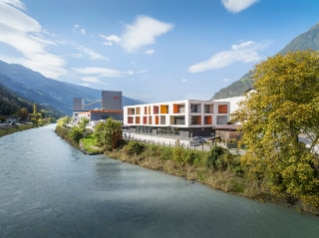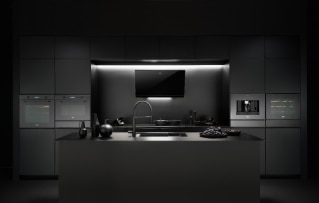In 2005, you inaugurated the Arper Environmental Department. What inspired the company to invest in sustainability before this word became as popular and fashionable as it is today?
The need stemmed from the desire to pursue a sense of usefulness that goes beyond the obvious usefulness of the products and accessories that make the environment in which you live pleasant. We also wanted to interact with the surrounding environment and the social and productive context through the little actions that everyone can do to improve the situation. The concept of sustainability summarizes this drive and is the result of a process, because you can’t just say “I make a recyclable product and therefore I am sustainable”. Working with foreign markets has also helped us – Arper has always exported around 90-93% of its products, and this has led us to get in touch with more evolved markets, which paid more attention to sustainability than the Italian markets of the early 2000s, when this concept was still pretty much unclear. For this reason, we created the Arper Environmental Department, where a team specifically focused on these issues worked in close collaboration with the product development department.

Do you believe that the concept of sustainability still is a little unclear today?
We operate in a market where sustainability is often mentioned inappropriately – sometimes those who ask you to be more sustainable haven’t even bothered to understand if what they’re talking about makes sense or is unfeasible. The sustainable company is a complex system, and it is its complexity that must be sustainable, otherwise it becomes a manneristic exercise with an opportunistic aim. However, I believe that 2019 was a watershed year. Greta Thumberg’s movement reflected the feelings of young people, rightly concerned about pollution and demographic issues. Dealing with natural resources is dutiful and obligatory, and Europe’s plan for the Recovery Fund bodes well, showing how sustainability is a duty but also a great opportunity.

Arper has recently finished analyzing the environmental performance of some of its the products. How is this analysis done?
I cannot explain that a given chair consumes less energy than its previous version if I do not have a way to measure it. That’s why we used four labels, four parameters that could summarize this complexity and that were at the same time easy to understand even by end consumers – the carbon footprint, the total water consumption, the percentage of recycled materials, the percentage of recyclable materials. In the future, we’d love to create a certification that summarizes in a synthetic way the level of sustainability, as is the case for household appliances or homes. In this way, the consumer could be left to choose not only on the basis of aesthetics or price, but also on the basis of energy consumption.
Among the latest additions to this year’s catalog, we find the Aston Club armchair, designed by Jean-Marie Massaud. A real source of pride since every component is recyclable. What did you do to achieve this astonishing result?
Creating a recyclable product means thinking about how to replace its components and how to set up its re-industrialization. On the other hand, the characteristics of the materials are constantly evolving. At the beginning of 2000, there were very few recycled plastics, while today it has become a bit simpler, even if the aesthetic factor and mechanical resistance are two big problems. As for aesthetics, which in furniture is a primary factor, it is necessary to stop requiring perfection from a product – as for the knots in wood, it is necessary to accept the intrinsic characteristics of the product, and not think that they’re imperfections. If I want a sustainable seat made of recycled plastic, I have to accept the idea that it can have some flaws. A perfect recycled plastic would imply such an intense treatment process that it would end up being a contradiction.

There’s also the Adell seat designed by Lievore + Altherr Désile Park, where the shell is made of 80% recycled polypropylene plastic, and its texture and handmade concentric-pattern finish evokes tree rings and seashells. Today, we feel like plastic is the antithesis of nature. And yet, you were specifically inspired by nature to create this piece of furniture made of plastic. How did it happen?
We tried to make a connection – we created a recycled product with an aesthetics that made the surface of the product less synthetic, that closely resembled natural materials, even though we played with shapes that would have been difficult to reproduce without plastic. This summarizes the philosophy of our company and our principles, which is to make an educational path while remaining within a commercial discourse. The risk of creating a utopian path is that it is a discourse that we are the only ones to understand. Ours, instead, wants to be an understandable and shareable message.

Finally, a question on current events: congratulations on the appointment as President of Federlegno. What is the strategic rethink and priorities you see for the Federation in such a delicate and particular phase of economic recovery?
The period is clearly not the best, we are in command of the ship in the middle of the storm: of course it is easier to arrive when all goes well, but there are some circumstances that you can not choose. In my program there are five main important points and the first is the one we have talked about so far: sustainability. It is a great opportunity for our system, which must become aware that the allocated funding is not a sterile support to the sector, but a boost to sustainable conversion that the Federation must encourage, stimulating companies to seize the opportunity and facilitating access to resources. This goes hand in hand with the second point, the network of the supply chain and human capital: the Federation must support our companies, especially the smallest ones, to remain stronger in the globalized market also through training centers that are already on the territory and need coordination.
And the other points?
The third point is about business culture. With Assarredo I tried to establish a new way of working also through AssarredoLAB, a format that allowed us to meet more than 600 entrepreneurs with whom we shared the work themes identified by the Board and from which we gathered feedback and needs. In order to evolve the business culture we need travel companions: I look at what we are already doing with the academic world and PoliDesign, but I think also the Triennale, the spearhead of our culture. Another point is the relationship with Confindustria, a strategic partner with which we must strengthen collaboration and coordination, also with the aim of not duplicating services. The last point, finally, concerns digitization and events. The Salone del Mobile in Milan is the showcase of our sector, over the years we have managed to make it the main point of reference in the world of furniture and wood. This asset must be further enhanced, strengthening that part of the Salone that has not been developed enough, the digital one. For this reason, we are working to make sure that through an enhanced portal the Salone will not only gain a physical leadership, but also a virtual one.
Did you miss the Salone this year?
I missed it and we all missed it very much, not only us as involved professionals, but also Milan and Italy because the energy generated by the fair is unparalleled. And we are already eager to participate to next year's Salone, hoping that it will turn into a good sign of recovery for the post-Covid period.
Opening picture, the Adell chair, photo Salva Lopez

























